|
NÁNDOR WAGNER 1922-1997
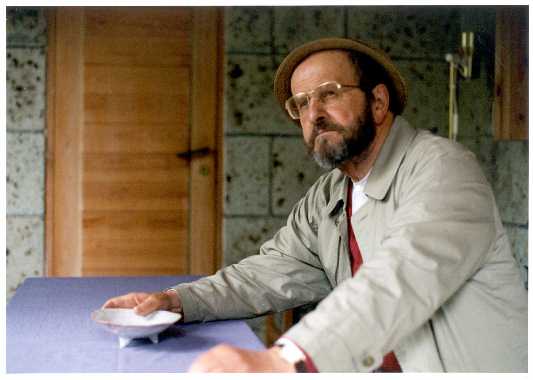 Nándor
Wagner sculptor was born in Nagyvárad, on 7th of October, 1922.
He attended school there and later studied sculptural arts and painting
at Academy of Fine Arts in Budapest. He evinced of his talent for
drawing, creating objects and designing furniture as well at this
early age. Nándor
Wagner sculptor was born in Nagyvárad, on 7th of October, 1922.
He attended school there and later studied sculptural arts and painting
at Academy of Fine Arts in Budapest. He evinced of his talent for
drawing, creating objects and designing furniture as well at this
early age.
After the war
in his studio at Ybl Bazár in Budapest he created statues:
the "Corpus Hungaricum", "Attila József the
poet" and "Sorrow of Mother" among others. Jointly
with Zoltán Farkasdy architect they won first prize with their
plan titled "Fountain with three boys" at the competition
for art composition to Jászai Mari square just at the foot
of the Margit Bridge in 1955. Besides and parallel to making sculptures
he organised the local historical collection at St. István
Museum of Székesfehérvár with placing the objects
found at excavations in a correctly reconstructed environment created
by artist between 1952-56. This activity has been recognized and honoured
by the British Museum.
He gave courses
in art to talented students who were refused to enter universities
before the 1956 revolution. He was elected to be a board member of
the Revolutionary Committee of the Artist during the revolution. He
worded his adherence as "We who are working at the museums had
only one oath: to protect the Hungarian culture with all our strength,
without any condition!" and called upon art students to take
drawing tools instead of guns to record the moments of revolution
on the streets for the future.
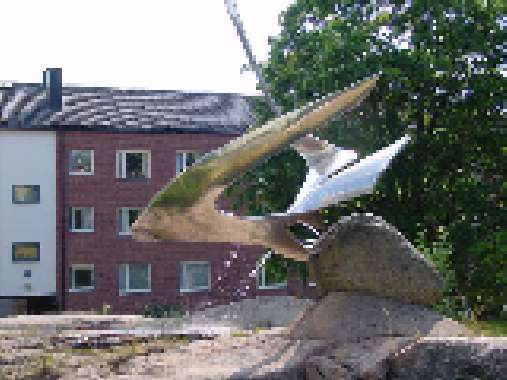 After
the Soviet army suppression of the Hungarian Revolution he had to
leave Hungary and Sweden received him and his family. Soon he established
his studio in Lund. He invented a new calculation method how to overcome
the shrinkage problem at casting large-scale statues and art objects
from stainless steel. Eight such monuments were erected around the
country among them "War Memorial for Polish Soldiers", "Tranås",
"Fountain with four children" and "Clown". He
was very active and inventive also in painting and drawing. He developed
a novel painting technique that he named as paper fresco. Here basically
the paper pulp was carried up in few centimetres thickness and the
paint was applied to colour some part of the pulp itself, but after
drying chiselling was also applied to get the paper fresco final form. After
the Soviet army suppression of the Hungarian Revolution he had to
leave Hungary and Sweden received him and his family. Soon he established
his studio in Lund. He invented a new calculation method how to overcome
the shrinkage problem at casting large-scale statues and art objects
from stainless steel. Eight such monuments were erected around the
country among them "War Memorial for Polish Soldiers", "Tranås",
"Fountain with four children" and "Clown". He
was very active and inventive also in painting and drawing. He developed
a novel painting technique that he named as paper fresco. Here basically
the paper pulp was carried up in few centimetres thickness and the
paint was applied to colour some part of the pulp itself, but after
drying chiselling was also applied to get the paper fresco final form.
In Sweden he was active
with industrial design as well, got a patent for a new line of street
lighting fixtures and also a model chair to ergonomic design has
been developed by him. Although the Swedish period of his life was
perhaps the most productive but privation and hardship came along
with it and he was driven away from his family. At the Art Academy
of Lund he was teaching drawing based on his skeleton support approach
a novelty again. Here at the Academy he met Chiyo Akiyama art student
who became his wife and partner for the rest of his life.
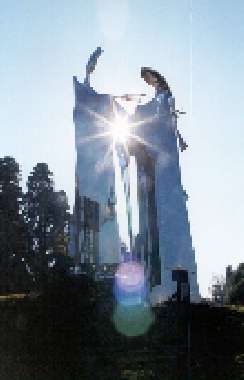 The
third period of his life started in Japan in 1969, where his art opened
at full scale. First the Wagner couple built a studio by themselves
in Mashiko Tochigi ken, primarily known for its local pottery Mashiko
ware. The studio was ready and he got clay in his hand on 31 of December,
1970 and "Mother with Child" a terracotta piece was born.
His name was founded in Japan by winning the contest of creating large
size art objects for the hotel area of the New International Tokyo
Airport in Narita. A six-meter tall two figure the statue of Gods
of Travellers (Dosojin) was erected and also a 12m in diameter rainbow
fountain was placed in front of Narita View Hotel both made from stainless
steel. Also he got the commission to design and construct the surrounding
park. The
third period of his life started in Japan in 1969, where his art opened
at full scale. First the Wagner couple built a studio by themselves
in Mashiko Tochigi ken, primarily known for its local pottery Mashiko
ware. The studio was ready and he got clay in his hand on 31 of December,
1970 and "Mother with Child" a terracotta piece was born.
His name was founded in Japan by winning the contest of creating large
size art objects for the hotel area of the New International Tokyo
Airport in Narita. A six-meter tall two figure the statue of Gods
of Travellers (Dosojin) was erected and also a 12m in diameter rainbow
fountain was placed in front of Narita View Hotel both made from stainless
steel. Also he got the commission to design and construct the surrounding
park.
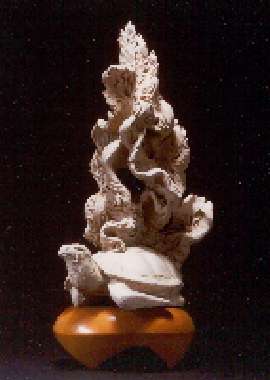 Parallel
to sculpting he started to paint fine aquarelles and creating more
ceramics. His figures of the "Silk Road" are the best example
how to connect the styles of East and West. Parallel
to sculpting he started to paint fine aquarelles and creating more
ceramics. His figures of the "Silk Road" are the best example
how to connect the styles of East and West.
During the seventies the
Tao Research Institute of World was founded by them from earnings
of their artists' activities, which has been supporting selected young
talented but poor artists who are devoted to make this world more peaceful
and better place to live in it. Around that time his attention was
turning to the spiritual essence of the world and development of culture.
He was trying to find a synthesis of the religious and cultural relationship.
Here in Mashiko the "Garden of Philosophy"
was born an important spiritual message to the current and next generations.
This composition was made in peace and harmony but not to make money
he said. Three complete sets were cast one for Japan, one for Hungary
and one for USA. The set that was presented to Hungary in 1997 was
unveiled on the Gellért Hill on 18th of October, in 2001. His message was quoted at time of unveiling:
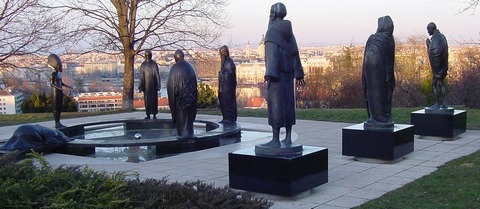
"The historical
importance of Hungary has been called. We are the connection point!
Hungary has a connecting role! This fact should be honoured! This
is the way of our mother country! This is our share of inheritance!"
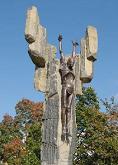 His
life of work and devotion to Hungary was honoured by the city of Székesfehérvár
by erecting the Corpus Hungaricum. The statue is symbolising the raise
of Hungarians. When he learned the decision of the city he said: "I
am deeply impressed. I do not want even to name my name. The name
is not important. I want the people to get the spiritual message and
I hope they will find it as their own." In 1999 he was posthumous
granted "Honorary Citizenship of Székesfehérvár".
Since the unveiling ceremony held on 6th October, 1999 this statue
has been saluted as remembrance place each year for 13 Hungarian generals
of 1848-49 revolution who were executed in Arad by the vengeful Austrians.
On this day we remember all Hungarian victims of the wars, revolutions
and invasions. His
life of work and devotion to Hungary was honoured by the city of Székesfehérvár
by erecting the Corpus Hungaricum. The statue is symbolising the raise
of Hungarians. When he learned the decision of the city he said: "I
am deeply impressed. I do not want even to name my name. The name
is not important. I want the people to get the spiritual message and
I hope they will find it as their own." In 1999 he was posthumous
granted "Honorary Citizenship of Székesfehérvár".
Since the unveiling ceremony held on 6th October, 1999 this statue
has been saluted as remembrance place each year for 13 Hungarian generals
of 1848-49 revolution who were executed in Arad by the vengeful Austrians.
On this day we remember all Hungarian victims of the wars, revolutions
and invasions.
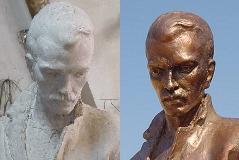 Some statues are coming out of darkness. The secco of József Attila statue (1953) was sleeping for more than 50 years in the cellar of the Saint Stephen Museum in Székesfehérvár. According to Nandor Wagner's will this statue was presented to his beloved native town Nagyvárad (now Oradea, Romania). The József Attila statue first was placed for two weeks in the garden of Petofi Museum of Literature the welcome the centenial anniversery celebrations. By that time the postament was ready for the statue in Schlauch Park, Nagyvárad as well. On 1st of May, 2005 József Attila arrived home and took his final position just in front of the school where Nandor had stated to learn sculpting. Some statues are coming out of darkness. The secco of József Attila statue (1953) was sleeping for more than 50 years in the cellar of the Saint Stephen Museum in Székesfehérvár. According to Nandor Wagner's will this statue was presented to his beloved native town Nagyvárad (now Oradea, Romania). The József Attila statue first was placed for two weeks in the garden of Petofi Museum of Literature the welcome the centenial anniversery celebrations. By that time the postament was ready for the statue in Schlauch Park, Nagyvárad as well. On 1st of May, 2005 József Attila arrived home and took his final position just in front of the school where Nandor had stated to learn sculpting.
During the most difficult
years of the Second World War and all his life he helped those in
need with no regard to where or which race they belonged to. He communicated
and transferred the thoughts and experience of his life at Tao Institute.
His profession of art was:
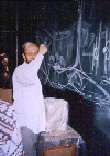 |
"My activity
here in Japan is trying to support of the creditability of Hungarians.
I do believe in the importance of my activity. I am sure that
my work is helping my country and we have to follow the road was
shown by István Széchényi if this nation
were to live. The exit road from the poverty and humiliation should
be found! I do believe my work is a small step on the right road!" |
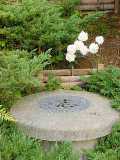 |
He passed away in Moka
near his studio on 15th of November, 1997. The place for his grave
was selected and prepared by him in the garden of his Mashiko studio.
|
 Nándor
Wagner sculptor was born in Nagyvárad, on 7th of October, 1922.
He attended school there and later studied sculptural arts and painting
at Academy of Fine Arts in Budapest. He evinced of his talent for
drawing, creating objects and designing furniture as well at this
early age.
Nándor
Wagner sculptor was born in Nagyvárad, on 7th of October, 1922.
He attended school there and later studied sculptural arts and painting
at Academy of Fine Arts in Budapest. He evinced of his talent for
drawing, creating objects and designing furniture as well at this
early age. After
the Soviet army suppression of the Hungarian Revolution he had to
leave Hungary and Sweden received him and his family. Soon he established
his studio in Lund. He invented a new calculation method how to overcome
the shrinkage problem at casting large-scale statues and art objects
from stainless steel. Eight such monuments were erected around the
country among them "War Memorial for Polish Soldiers", "Tranås",
"Fountain with four children" and "Clown". He
was very active and inventive also in painting and drawing. He developed
a novel painting technique that he named as paper fresco. Here basically
the paper pulp was carried up in few centimetres thickness and the
paint was applied to colour some part of the pulp itself, but after
drying chiselling was also applied to get the paper fresco final form.
After
the Soviet army suppression of the Hungarian Revolution he had to
leave Hungary and Sweden received him and his family. Soon he established
his studio in Lund. He invented a new calculation method how to overcome
the shrinkage problem at casting large-scale statues and art objects
from stainless steel. Eight such monuments were erected around the
country among them "War Memorial for Polish Soldiers", "Tranås",
"Fountain with four children" and "Clown". He
was very active and inventive also in painting and drawing. He developed
a novel painting technique that he named as paper fresco. Here basically
the paper pulp was carried up in few centimetres thickness and the
paint was applied to colour some part of the pulp itself, but after
drying chiselling was also applied to get the paper fresco final form.
 The
third period of his life started in Japan in 1969, where his art opened
at full scale. First the Wagner couple built a studio by themselves
in Mashiko Tochigi ken, primarily known for its local pottery Mashiko
ware. The studio was ready and he got clay in his hand on 31 of December,
1970 and "Mother with Child" a terracotta piece was born.
His name was founded in Japan by winning the contest of creating large
size art objects for the hotel area of the New International Tokyo
Airport in Narita. A six-meter tall two figure the statue of Gods
of Travellers (Dosojin) was erected and also a 12m in diameter rainbow
fountain was placed in front of Narita View Hotel both made from stainless
steel. Also he got the commission to design and construct the surrounding
park.
The
third period of his life started in Japan in 1969, where his art opened
at full scale. First the Wagner couple built a studio by themselves
in Mashiko Tochigi ken, primarily known for its local pottery Mashiko
ware. The studio was ready and he got clay in his hand on 31 of December,
1970 and "Mother with Child" a terracotta piece was born.
His name was founded in Japan by winning the contest of creating large
size art objects for the hotel area of the New International Tokyo
Airport in Narita. A six-meter tall two figure the statue of Gods
of Travellers (Dosojin) was erected and also a 12m in diameter rainbow
fountain was placed in front of Narita View Hotel both made from stainless
steel. Also he got the commission to design and construct the surrounding
park.  Parallel
to sculpting he started to paint fine aquarelles and creating more
ceramics. His figures of the "Silk Road" are the best example
how to connect the styles of East and West.
Parallel
to sculpting he started to paint fine aquarelles and creating more
ceramics. His figures of the "Silk Road" are the best example
how to connect the styles of East and West.
 His
life of work and devotion to Hungary was honoured by the city of Székesfehérvár
by erecting the Corpus Hungaricum. The statue is symbolising the raise
of Hungarians. When he learned the decision of the city he said: "I
am deeply impressed. I do not want even to name my name. The name
is not important. I want the people to get the spiritual message and
I hope they will find it as their own." In 1999 he was posthumous
granted "Honorary Citizenship of Székesfehérvár".
Since the unveiling ceremony held on 6th October, 1999 this statue
has been saluted as remembrance place each year for 13 Hungarian generals
of 1848-49 revolution who were executed in Arad by the vengeful Austrians.
On this day we remember all Hungarian victims of the wars, revolutions
and invasions.
His
life of work and devotion to Hungary was honoured by the city of Székesfehérvár
by erecting the Corpus Hungaricum. The statue is symbolising the raise
of Hungarians. When he learned the decision of the city he said: "I
am deeply impressed. I do not want even to name my name. The name
is not important. I want the people to get the spiritual message and
I hope they will find it as their own." In 1999 he was posthumous
granted "Honorary Citizenship of Székesfehérvár".
Since the unveiling ceremony held on 6th October, 1999 this statue
has been saluted as remembrance place each year for 13 Hungarian generals
of 1848-49 revolution who were executed in Arad by the vengeful Austrians.
On this day we remember all Hungarian victims of the wars, revolutions
and invasions. Some statues are coming out of darkness. The secco of József Attila statue (1953) was sleeping for more than 50 years in the cellar of the Saint Stephen Museum in Székesfehérvár. According to Nandor Wagner's will this statue was presented to his beloved native town Nagyvárad (now Oradea, Romania). The József Attila statue first was placed for two weeks in the garden of Petofi Museum of Literature the welcome the centenial anniversery celebrations. By that time the postament was ready for the statue in Schlauch Park, Nagyvárad as well. On 1st of May, 2005 József Attila arrived home and took his final position just in front of the school where Nandor had stated to learn sculpting.
Some statues are coming out of darkness. The secco of József Attila statue (1953) was sleeping for more than 50 years in the cellar of the Saint Stephen Museum in Székesfehérvár. According to Nandor Wagner's will this statue was presented to his beloved native town Nagyvárad (now Oradea, Romania). The József Attila statue first was placed for two weeks in the garden of Petofi Museum of Literature the welcome the centenial anniversery celebrations. By that time the postament was ready for the statue in Schlauch Park, Nagyvárad as well. On 1st of May, 2005 József Attila arrived home and took his final position just in front of the school where Nandor had stated to learn sculpting.
